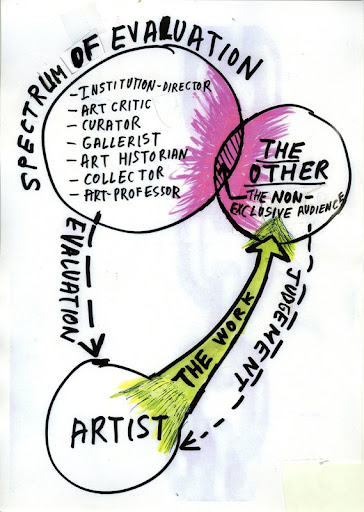Making a Scene: Anticipatory Artworlds Sprint
‘Making a Scene: Anticipatory Artworlds’ is a two-week learning sprint, the second in the 40 Credit Themes Course within the MA Contemporary Art Theory programme.

Thomas Hirschorn, The Spectre of Evaluation (2012)
…In that Empire, the art of Cartography attained such perfection that the map of a
single province occupied the entirety of a city, and the map of the empire, the entirety
of a province. In time, those unconscionable maps no longer satisfied, and the
Cartographers Guilds struck a map of the wmpire whose size was that of the wmpire, and
which coincided point for point with it. The following generations, who were not so
fond of the study of cartography as their forebears had been, saw that that vast Map
was useless, and not without some pitilessness was it, that they delivered it up to the
inclemencies of sun and winters. In the deserts of the west, still today, there are
tattered ruins of that map, inhabited by animals and beggars; in all the land there is
no other relic of the disciplines of geography. (Borges, 1946)
Provocation:
When confronted by the seemingly absolute complexity of conceptualising the world and specifically the artworld, any artworld or indeed our own artworld, how does one orientate themselves in these abstractions?
How do we find our bearings? How can we cognitively map our surroundings? And how can we use these experiences to make more worlds or our own anew?
Considering, studying, composing (and/or co-composing), artworlds involves mapping, organising and orientating ourselves in relation to how they come into being and continue existing. Specifically it often involves ordering impermanent worlds in which learning and growth can occur . This is where worlds overlap, intersect with, and draw from our own. In other words, artworlds are about world-making (Chia,1998; Goodman, 1978; Haraway, 2012).
Artworlds are temporary and offer their inhabitants and/or constituents the potential to experience and explore becoming otherwise (Bennett & Connelly, 2012). These temporary worlds attempt to host processes through which new configurations of being can become possible, if only momentarily. They facilitate the production of alternatives to the ‘actual’ world in temporary parallel ones established and sustained by the collective cognitive event of making and experiencing art. These worlds are an acknowledgement that matter is always in flux, and as such learning and making is always ongoing, is always fluctuating between becoming and being, the known and unknown, the ordered and disordered. These worlds and our experiences in them not static, permanent, fixed, or rational.
Weird Resources
To begin with, here are evolving resource lists:
Week 3 Where and What? Making a Scene
Week 4 Where, What and How? Artworld-Making
Week 3
Pre-Diagnostic 1 | Pre-Diagnostic 2 | A pair of short online diagnostics to ascertain what you know (and don’t know) about the forthcoming theme of “weird studies”. Add this to your Portfolio.
Monday 4th October | Day One – It Matters What Matter We Use to Matter our Worlds |Jake Watts | R.02B, Hunter Building, Lauriston
10:00-10:30 Introduction to sprint theme
10:30-12:30 Fool Me, Fool Me Workshop

Jake Watts Fool Me, Fool Me (2017)
Fool Me, Fool Me (2017) is a mapping workshop intended to plot the people and things who constitute an artworld for group of players. It is intended to help identify forms of knowledge and processes of learning that the group does, or might, produce. Allowing players to make visible, or create, relationships between these materials to help provide ways to paragogically compose artworlds together.
Our version of Fool Me, Fool Me will be mediated via a Miro Board (Password: MACATS)
Day 2 – Wednesday – Artworlds | October 27th 2021
Please follow the link above to the Classwork for this week of the Sprint.
10:00-10:30 Screen ‘Powers of Ten’ (Eames, 1977)
10:30-11:30 Bashos meet to discuss the mandatory reading and their bespoke reading.
11:30-12:30 Jigsaw Groups – All bashos meets in a jigsaw formation to pool and share the research they conducted on individually and discussed in their bashos.
Please work in the Lecture Theatre O17, Hunter Building, Lauriston where you can work exclusively alongside yours peers (CATs) the lecture theatre projector will be used to screen ‘Playtime’ by Jaques Tati (1967).